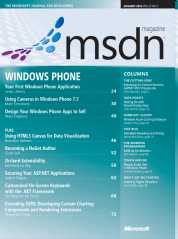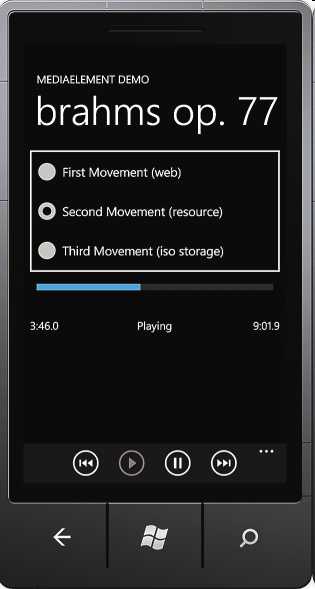| MSDN Magazine January 2011 - Windows Phone 7 |
| Written by Mike James | |||
| Tuesday, 10 January 2012 | |||
|
It's the start of a new year and the start of a new volume for MSDN Magazine. January 2012's issue is Vol 27, No 1. Does the new volume reflect the major changes at Microsoft? How different is volume 27 going to be from volume 1, or even volume 26 for that matter? Things are changing in the Microsoft world and you would expect that to be reflected in MSDN Magazine - it is, but at the moment only just. We do have articles on WP7, but where are the articles on Windows 8 and WinRT and the whole revolution that threatens to sideline .NET and Silverlight? What insights do we have about the future and how Microsoft programming is evolving?
This issue has three main articles on Windows Phone 7. The first is an introduction by Jesse Liberty to creating your first WP7 app - Your First Windows Phone Application. Great, but surely MSDN Magazine should be concentrating on more advanced WP7 topics by now? The introduction goes through the standard steps of creating a WP7 phone example, which are more or less the same as the steps for a Silverlight example. About the only thing that you might find novel is that Expression Blend is used to design the interface. It covers using isolated storage and the life-cycle of a WP7 app. If you haven't worked with Silverlight or want a very basic introduction to WP7 then it does the job. Using Cameras in Your Windows Phone Application is little bit more interesting as it deals with using the front and back cameras that were introduced in WP7.5. It doesn't cover the basic camera capture API, which is as it should be. It covers accessing the camera preview buffer and recording video. Design Your Windows Phone App to Sell! sounds like the first article you should read but don't get too excited. What it actually is is a lecture on design and Metro design principles in particular. Now, I have no claim to be much of a designer - in fact most of my self- build UIs are usually referred to a "retro", but I know what I like and I really can't see the attraction of Metro. If anything looks retro it is Metro and, from my point of view, this isn't good. If you still want to read an article that advocates drawing out your design on small bits of paper, then go ahead. Personally, I could knock up a prototype in the time it would take me to draw the screens on paper.
Moving on from WP7, Using HTML5 Canvas for Data Visualization which is another very, very basic introduction. If you know that Canvas is a 2D bitmap drawing element then you can probably work out the majority of this article just by reading the documentation. There is a breath of reality, however, towards the end of the article, where testing for browsers earlier than IE9 is discussed. Now if only the same honesty was applied to testing for the presence of IE, when WebGL, the 3D context of Canvas, was being used. Becoming a NuGet Author is a niche article if ever I read one. It is as if the Microsoft world gets a single credible open source program and feels the need to keep writing about it. If you do want to author a NuGet package then the article is good, readable, well written, and on topic. Talking of open source, Orchard Extensibility is another article focusing on a little-known open source project. Orchard is a CMS based on ASP.NET and if you are using it, or are interested in using it, then you might want to read this article on how to extend it. For a return to good old fashioned programming values you need to read Customized On-Screen Keyboards with the .NET Framework. This isn't an advanced look at popup keyboards that appear in WP7 or some other mobile device, but a very basic look at how to create keyboards using a form and some DLL calls in standard .NET. This may not be cutting edge, but it is interesting and useful.
The main part of the issue finishes with two interesting articles The next part in a short series on Securing Your ASP.NET Applications looks at cross-site scripting and other exploits and Extending SSRS: Developing Custom Charting Components and Rendering Extensions explains how to extend SQL Sever Reporting Services. The regular columns have some interesting reads, but my favourite has to be the algorithm-oriented Simulated Annealing and Testing, but Building Combinators comes a very close second. For ASP.NET programmers we have Enhancing the Context-Sensitive ASP.NET MVC Progress Bar and for database programmers Making Do with Absent Foreign Keys.
Charles Petzold's column is put under the spotlight by the editor's note pointing out that he has been writing A Quarter Century and Counting for MSDN Magazine for 25 years. Yes, his sort of practical article made MSDN Magazine a success and if it wants to remain a success I would suggest they need more like him writing about the new Microsoft technologies. His latest column is a practical look at how to play music on WP7, Playing Audio Files in Windows Phone, and the good news is the examples are of multi-track classical music - the one big group of music consumers who are almost totally ignored by music player developers.There is a developer opportunity here!
You can see the entire current issue at MSDN Magazine.
Comments
or email your comment to: comments@i-programmer.info
To be informed about new articles on I Programmer, subscribe to the RSS feed, follow us on Google+, Twitter, Linkedin or Facebook or sign up for our weekly newsletter.
|
|||
| Last Updated ( Tuesday, 10 January 2012 ) |





